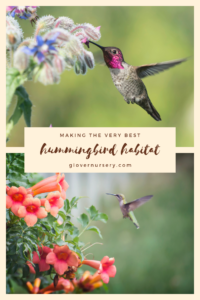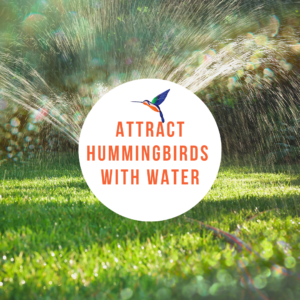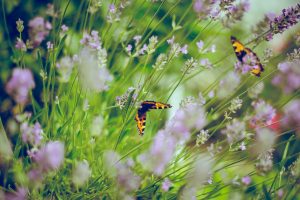Hummingbird Season is Upon Us!
We love these jewels of the sky! These beautiful birds arrive in Utah in late April/mid-May and stay through September. It’s best to prepare your habitat before hummingbirds arrive. However, it’s not too late to attract these fascinating birds to your yard.
 Many migratory hummingbirds, the breeding natives, arrive in Utah sometime in April or early May. It varies year to year depending on changing environmental factors. Like many wild animals, the male of the species is much more flashy than the female. They normally have colorful throats and tails and sometimes will whistle as they fly.
Many migratory hummingbirds, the breeding natives, arrive in Utah sometime in April or early May. It varies year to year depending on changing environmental factors. Like many wild animals, the male of the species is much more flashy than the female. They normally have colorful throats and tails and sometimes will whistle as they fly.
The best way to attract these jewels of the sky is to provide the necessities for their perfect habitat. The more of these you can provide in your own backyard the better chance you will have of daily hummingbird visitors. We’ve put together 5 guiding principles to make the perfect Hummingbird Habitat in your Utah yard.
Nectar
When you bring up hummingbirds most people think immediately of red sugar water. But, that’s not the only way to attract hummingbirds. A hummingbird feeder is a great way to supplement native sources of nectar in your yard. However, using native and non-native plants is the best source for these active birds.
Thoughtful plantings of native nectar sources can provide an uninterrupted food source throughout their stay. Because hummingbirds are well adapted to native plants they are the best way to invite hummingbirds to your yard. Native plants also make your yard a perfect nesting spot year after year.
Consider adding the following fantastic sources of nectar to your landscape.
Native Nectar Sources
- Aquilegia formosa
- Aquilegia chrysantha
- Aquilegia scopulorum
- Asclepias tuberosa
- Campsis radicans
- Chilopsis linearis
- Heuchera parvifolia
- Ipomopsis aggregate
- Lobelia cardinalis
- Lonicera involucrate
- Monarda fistulosa
- Penstemon barbatus
- Penstemon cyanthus
- Penstemon eatoni
- Penstemon palmeri
- Penstemon pseudospectabilis
- Penstemon strictus
- Ribes aureum
- Symphoricarpos albus
- Zauschneria garretii
- Zauschneria latifolia
Excellent non-native Nectar Sources
- Agastache
- Crocosmia
- Hesperaloe
- Hibiscus
- Hosta
- Kniphofia
- Lonicera japonica
- Lychnis chalcedonica
- Phlox
- Salvia
Hummingbird Feeder Solution
We have the best Hummingbird Feeder Recipe. Again, we want to make sure and point out that a hummingbird feeder should be used as a second source of food for these busy little birds.
Supplemental feeders should be filled with a solution of four parts water to one part white sugar. Feeders can ferment if left too long. Keep your feeder fresh by cleaning them well and replacing sugar water before it begins to ferment.
Sometimes hummingbirds become territorial of a feeder. To avoid this behavior feeders should hang at a distance from each other or out of sight from one another.
Water
Shallow water attracts hummingbirds. Traditional birdbaths tend to be too deep for these tiny birds. As a solution, you can fill your birdbath part way with pebbles and rocks to make them more suitable. We have a variety of birdbaths available at the nursery and filler too!
 Hummingbirds also like moving / natural bird baths. They will bathe in sprinklers, misters and water droplets that have collected on large leaves. Planting Cannas and Hostas in your yard will create a natural birdbath for hummingbirds.
Hummingbirds also like moving / natural bird baths. They will bathe in sprinklers, misters and water droplets that have collected on large leaves. Planting Cannas and Hostas in your yard will create a natural birdbath for hummingbirds.
Perching Sites, Nesting Sites and Nesting Materials
Hummingbirds will create their home in a place with natural materials readily available. Providing perching sites, nesting sites and nesting material is a great way to encourage hummingbirds to take up residence in your yard. And keep them from using your yard as just a pass through.
Trees, shrubs and vines offer protection from predators. These are also the perfect place to build a nest. Preferable nesting materials include moss, lichens, and fur. Pappus from seeds such as dandelions, thistle, aster and asclepias cotton also make great nesting materials. Surprisingly, spider webs are an especially important nest component.
Organic Gardening Practices
Nature is it’s own best exterminating system. Spiders and insects are a protein-packed meal for hummingbirds. We knew we loved these busy little birds!
Hummingbirds also use spider webs for nest building. Keeping an organic garden will allow nature to work at it’s best. A well-balanced backyard ecosystem is essential for providing sources of protein.
For more information on hummingbirds visit

